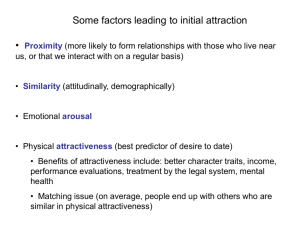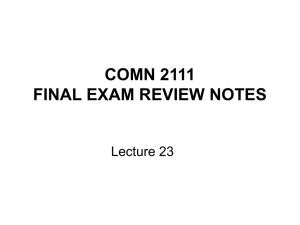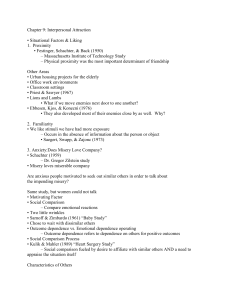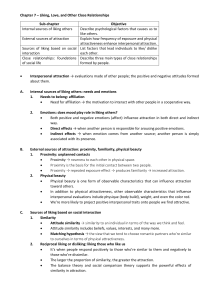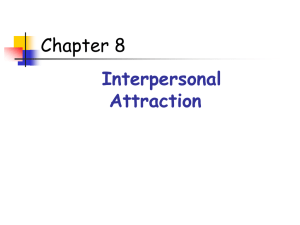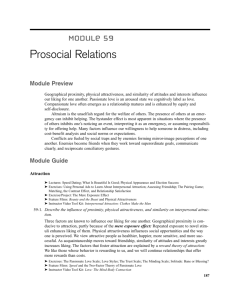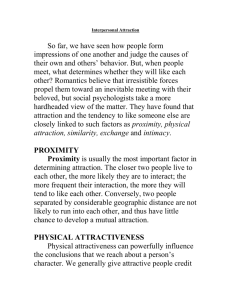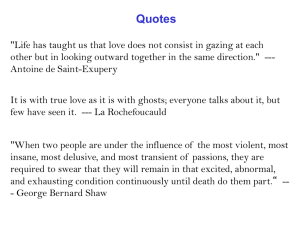Interpersonal Attraction - NAU jan.ucc.nau.edu web server
advertisement
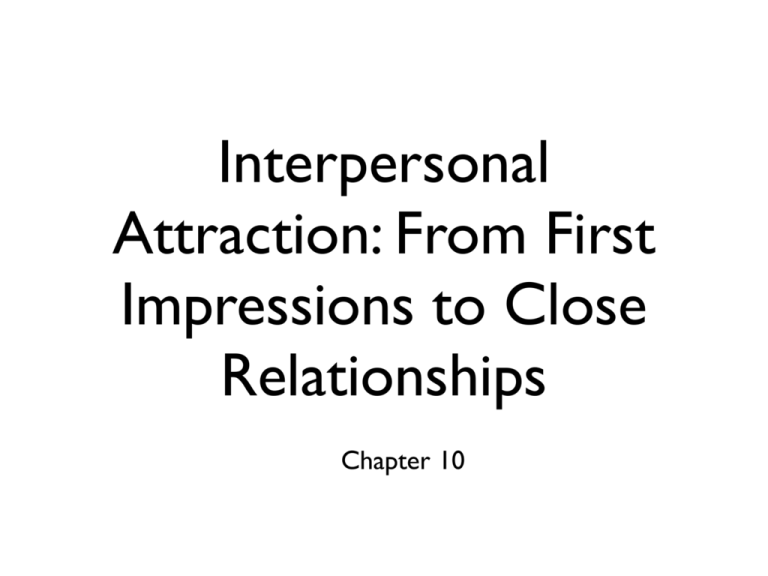
Interpersonal Attraction: From First Impressions to Close Relationships Chapter 10 What causes attraction? • People in close relationships are highly interdependent • feeling of “oneness” • another person becomes part of your “self” Propinquity • People you see and interact with the most often are most likely to become your friends (and perhaps more) • “mere exposure” effect: the more we see something (i.e., more familiar) the more we like it Exercise • Write down your favorite fruit, vegetable, and letter of the alphabet Similarity • match between two people’s interests, attitudes, values, backgrounds, and/or personality, fuels the development of relationships that begin based on propinquity • similarity in interpersonal style • similarity in interests and experiences 3 reasons similarity is important in attraction • we expect similar others to like us and are more likely to initiate relationships • similar others validate our characteristics and beliefs • we draw inferences about character based on perceived similarity Reciprocal Liking • If we think another person likes us, we’re more likely to like them • Self-fulfilling prophecy (we act more likable in their presence) • Low self-esteem people like those who criticize them better! Physical Attractiveness • major determinant of liking in studies of first impressions • both sexes rate physical attractiveness as important What is attractive? • Cultural norms transmitted via media • features listed in book • Appears to be some cultural consistency about what is attractive The power of Familiarity • Familiarity is a critical variable that explains attraction (why do couples look alike?) • Familiarity underlies propinquity, similarity, and reciprocal liking • We like what we know! What is beautiful is good • People assume that PA is highly correlated with other desirable traits (”what is beautiful is good” stereotype) • more sociable, extraverted, and socially competent • operates across cultures • kernel of truth (self-fulfilling prophecy; Snyder, Tanke, & Berscheid (1977) study) Initial Attraction • retrospective reports • Aron et al (1989) found reciprocal liking and attractiveness important for love; similarity and propinquity were less important. For friendships: reciprocal liking, attractiveness, similarity, and propinquity were all important • Duck (1994) physical attractiveness and similarity were strongest predictors of romantic attraction Theories of Interpersonal Attraction Social Exchange Theory • How people feel about a relationship depends on • their perceptions of the REWARDS and COSTS of the relationship • the kind of relationships they believe they deserve or expect to have (Comparison Level or CL) • their chances of having a better relationship with someone else (CL alt) Social exchange (con’t) • Outcome of relationship = rewards - costs • Satisfaction in relationship depends on CL • Whether or not you leave depends on CL alt • Research evidence supports the theory Long-term relationships • Rusbult’s investment model of relationships • Investments = something that would be lost if one left the relationship • greater the investment, less likely to leave • Commitment = satisfaction, CLalt, and investments Exchange Theory Demonstration • Need volunteers Equity Theory • People are happiest in relationships when rewards, costs, and contributions are equal to those of the other person • Under- and over-benefitted persons should be motivated to restore equity (most likely for under-benefitted!) Long-term relationships • Exchange relationships (tit for tat) • Communal relationships (accounting is looser and occurs over time) Close Relationships Defining Love • Companionate Love vs. Passionate Love • Triangular theory of love • Love styles Companionate vs. Passionate Love • Companionate love: feelings of love and affection we feel for another person, but not necessarily passion or arousal • Passionate love: intense longing, physiological arousal • Americans value PL over CL Triangular Theory of Love Love Styles • Basic theories people have about love that guide their behavior in relationships • Eros (passionate) • Ludus (love as a game) • Storge (love from friendship) • Pragma (pragmatic love) • Mania (roller-coaster love) • Agape (self-less love) • Hendrick & Hendrick (1986) find that men are more ludidc and women more storgic and pragmatic; no differences in eros and agape. • Real-life couples have similar love styles • Longer lasting relationships characterized by high eros and low ludus love Evolution and Choosing a Mate Attachment Style • People develop expectations about the trustworthiness of others and lovability of the self from earlier relationships with caregivers (Bowlby, Ainsworth) • Three attachment styles • Influence adult relationships Secure Attachment • responsive caregivers as infancts • trust, lack of concern with being abandoned • self is worthy and liked • others are reliable and trustworthy Avoidant Attachment • caregivers were aloof and distant • suppression of attachment needs because attempts to be intimate were rebuffed • self is worthy but others are not to be trusted • Difficult to develop intimate relationships Anxious/Ambivalent Attachment • inconsistent and overbearing caregivers • concerned that others will not reciprocate one’s desire for intimacy • high levels of anxiety • self is unworthy, others are trustworthy Attachment Style • early relationships develop into schemas for later relationships • can change over time and in the contexts of different relationships • see the female anxious/male avoidant pairing often (reverse doesn’t work well) Ending Relationships • American divorce rate is 50% • 2/3 of all current first marriages will end Duck’s 4 stages of dissolution • Intrapersonal (focusing on dissatisfaction) • Dyadic (revealing dissatisfaction to partner) • Social (announcing breakup to others) • Intrapersonal (devising accounts of the breakup as recovery begins) Rusbult • 4 types of behavior that occur in troubled relationships • exit (harming or terminating the relationship) • voice (actively constructively attempting to improve conditions) • loyalty (waiting for conditions to improve) • neglect (letting things deteriorate) Remaining facts • no gender differences in who initiates breakups • people who break up feel better, being dumped feels worse, and mutual are in the middle (no surprises there!) • 30% of breakups in college were “fatal attractions” qualities that were initially attractive became the reasons for the breakup Breaking Up

